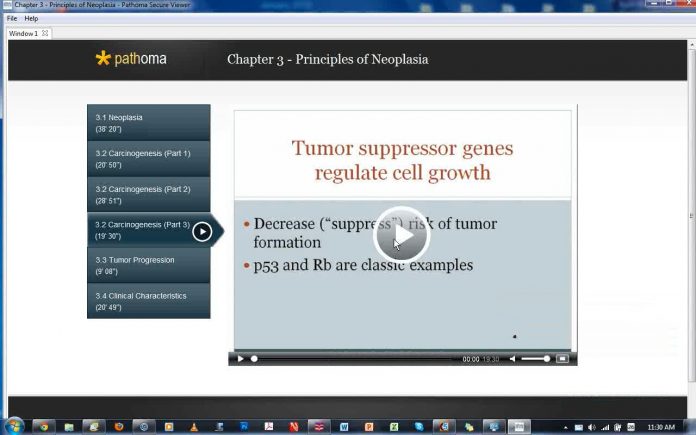CARCINOGENESIS
I. BASIC PRINCIPLES
A. Cancer formation is initiated by damage to DNA of stem cells. The damage
overcomes DNA repair mechanisms, but is not lethal.
i. Carcinogens are agents that damage DNA, increasing the risk for cancer.
Important carcinogens include chemicals, oncogenic viruses, and radial ion
(Table 3.2).
B. DNA mutations eventually disrupt key regulatory systems, allowing for tumor
promotion (growth) and progression (spread).
1. Disrupted systems include pro to-oncogenes, tumor suppressor genes, and
regulators of apoptosis.
II. ONCOGENES
A. P roto -oncoge n e s a re essential to r eel I g rowt h a nd d i ffere n t i at ion; m uta l io n s of
proto-oncogenes form oncogenes that lead to unregulated cellular growth.
B. Categories of oncogenes include growth factors, growth factor receptors, signal
transducers, nuclear regulators, and cell cycle regulators (Table 3.3).
1. Growth factors induce cellular growth (e.g., PDGFB in astrocytoma),
2. Growth factor receptors mediate signals from growth factors (e.g., ERBB2
[HF.R2/ueu\ in breast cancer).
3. S ign a 11 ra ns due e rs rel ay recepto r ac t i vat i on to th e n uc le us (e .g., ra s).
i. Ras is associated with growth factor receptors in an inactive GDP-bound
state.
ii. Receptor binding causes GDP to be replaced with GTP, activating ras.
iii. Activated ras sends growth signals to the nucleus.
iv. Ras inactivates itself by cleaving GTP to GDP; this is augmented by GTPase
activating protein,
v. Mutated ras inhibits the activity of GTPase activating protein. This prolongs
the activated state of ras, resulting in increased growth signals.
4, Cell cycle regulators mediate progression through the cell cycle {e.g., cyctin and
cyclin-dependent kinase).
i. Cyclins and cyclin-dependent kinases (CDKs) form a complex which
phosphorylates proteins that drive the cell through the cell cycle.
ii. For example, the cvclinD/CDK4 complex phosphorylates the retinoblastoma
protein, which promotes progression through the G^S checkpoint.
III. TUMOR SUPPRESSOR GENES
A. Regulate cell growth and, hence, decrease (“suppress”) the risk of tumor formation;
p53 and Rb (retinoblastoma) are classic examples.
K, p53 regulates progression of the cell cycle from Gt to S phase,
1. In response to DNA damage, p53 slows the cell cycle and upregulales DNA
repair enzymes.
2. If DNA repair is not possible, p53 induces apoptosis.
i. p53 upregulates BAX, which disrupts Bcl2.
ii. Cytochrome c leaks from the mitochondria activating apoptosis,
3. Both copies of the p53 gene must be knocked out for tumor formation (Knudson
two-hit hypothesis).
i. Loss is seen in > 50% of cancers.
ii. Germline mutation results in Li-Fraumeni syndrome (2nd hit is somatic),
characterized by the propensity to develop multiple types of carcinomas and
sarcomas,
C, Rb also regulates progression from G, to S phase.
1. Rb “holds” the E2F transcription factor, which is necessary for transition to the S
phase.
2. E2F is released when RB is phosphorylated by the cyclinD/cyclin-dependent
kinase 4 (CDK4) complex,
3. Rb mutation results in const it utively free E2F, allowing progression through the
cell cycle and uncontrolled growth of cells.
4. Both copies of Rb gene must be knocked out for tumor formation (Knudson twohit
hypothesis).
i. Sporadic mutation (both hits are somatic) is characterized by unilateral
retinoblastoma (Fig. 3,1).
ii, Germline mutation results in familial retinoblastoma (2nd hit is somatic),
characterized by bilateral retinoblastoma and osteosarcoma.
IV. REGULATORS OF APOPTOSIS
A. Prevent apoptosis in normal cells, but promote apoptosis in mutated cells whose
DNA cannot be repaired (e.g., Bcl2)
1. Bcl2 normally stabilizes the mitochondrial membrane, blocking release of
cytochrome c.
2, Disruption of Bcl2 allows cytochrome c to leave the mitochondria and activate
apoptosis.
B. Bcl2 is overexpressed in follicular lymphoma,
). t(14;!8) moves Bcl2 (chromosome 18) to the lg heavy chain locus (chromosome
14), resulting in increased Bcl2.
2. Mitochondrial membrane is further stabilized, prohibiting apoptosis.
3. B cells that would normally undergo apoptosis during somatic hypermutation in
the lymph node germinal center accumulate, leading to lymphoma.

